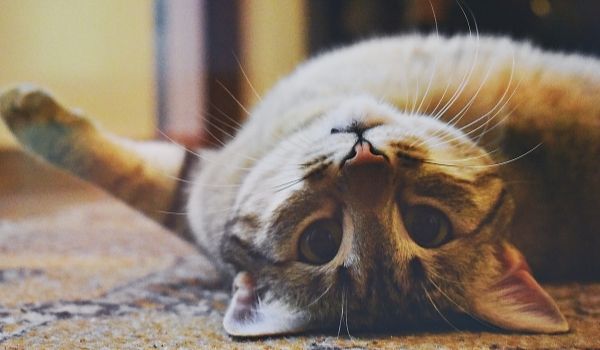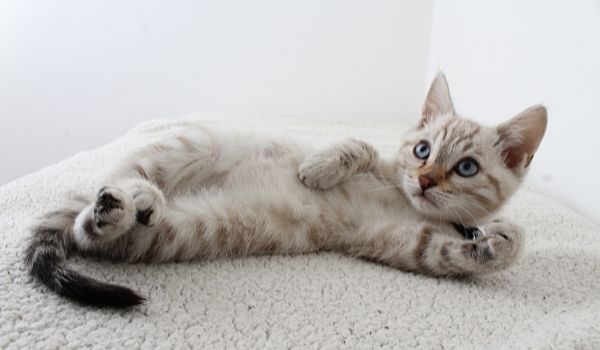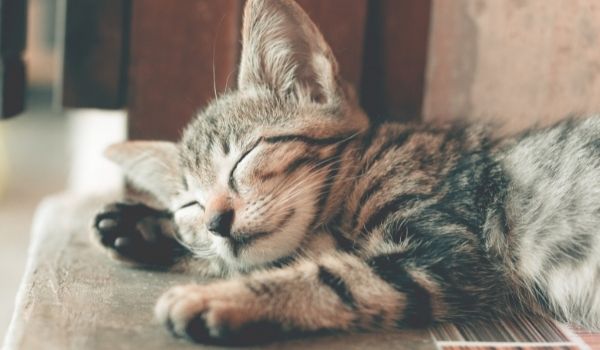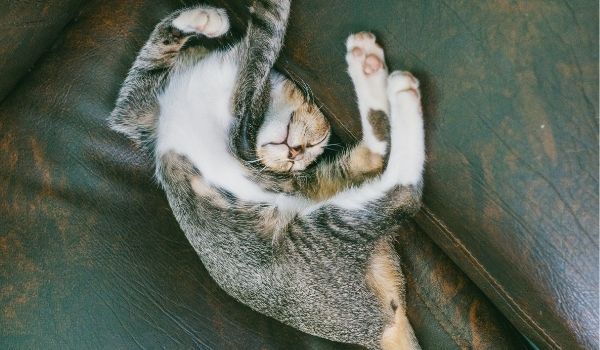We love our pets and enjoy the affection, warmth, and joy they bring in our lives. Naturally, when they show signs of discomfort or anomaly in their regular behavior, it upsets us gravely. Cat twitching is one such thing that worries pet parents, making them wonder if all is well with their little fluffy friend. Usually, it is normal for cats to display some physical behaviors, such as covering their face while asleep or sleeping with their eyes open. But certain behaviors may have more complicated underlying reasons that need thorough investigation.
What are the Causes of Cat Twitching?
Cat twitching may be a result of several issues. In the best-case scenario, if it is an occasional occurrence, it could just be an expression of normal feline behavior – cats tend to twitch their bodies during deep sleep (rapid eye movement stage of sleep). But if you notice them twitching very often, it could be due to an underlying medical condition.
Cats affected by an allergy, like the one caused by flea infestation, can also display twitching, scratching, and excessive grooming. Another explanation for this behavior is that your pet suffers from Hyperesthesia Syndrome, an amalgamation of symptoms caused by yet another set of medical issues. Or it may be possible that your cat is not twitching at all but is experiencing a seizure.
Apart from the expected feline behavior, all the other situations warrant medical attention. Getting a physical examination from a registered vet is better than constantly worrying or second-guessing the situation.
Possible Causes of Cat Twitching
Since cat twitching does not happen because of one definitive reason, a veterinary practitioner will employ an elimination technique where they rule out the less likely causes and then run some tests to identify what ails your feline buddy.
1. Cat Twitching While Dreaming
Just as humans toss and turn, roll over, and gain all sorts of funny postures in their sleep, cats too display certain behaviors. It does not involve any rocket science to make sense of some of the relaxed poses, where they curl themselves up, their head lying comfortably on their arms, or lazily sprawled atop their owners. But some, like twitching, have warranted a lot of interest and concern among the owners.
So, why do cats twitch in their sleep? Like other living beings, cats undergo the various stages of the sleep cycle, beginning with the catnaps, extending to the deep sleep called the Rapid Eye Movement stage, and back to light sleep, and on and on it goes.
During deep sleep, cats lose consciousness of their surroundings and possibly dream – yes, cats do dream. It is during this stage that cats twitch, as their neurons – the nerve cells that transmit messages between the body and brain – fire up, signaling their minds as they dream on.
The phenomenon is even more pronounced among kittens, who undergo an additional sleep stage called activated sleep. In this stage, their bodies undergo the development of their nervous system, hence far higher neuron firing than that in a fully-grown cat.
What to Do When Cat Twitches in Her Sleep?
Just let them be. Cats twitching lightly while dreaming is pretty normal. Kittens may experience it a bit more than fully-grown cats and tend to make quite a lot of noise while they are at it, but it is all considered normal feline behavior. Doing so is incredibly necessary for the proper growth and development of a kitten.
There is nothing to worry about in this case. You can provide soft, comfortable bedding secured at a higher ground to let them sleep peacefully and with a carefree mindset. If the noise bothers you, house them in a room different than yours and make an effort to make them feel at home there before fully shifting them.
2. Cat Twitching Due to Involuntary Muscle Trembling
It may happen that what you perceive as twitching is localized trembling. Felines are susceptible to a medical condition called the Involuntary Muscle Trembling, where the feline experiences uncontrolled contraction and relaxation of the muscles in any part of the body.
The trembling may either be generalized or localized. In generalized, the trembling is experienced, throughout the body, while in localized, it is only in a specific area. A myriad of causes could result in this condition, ranging anywhere from physical trauma, weakness, and toxicity to genetics, at-birth defects, and an illness affecting the nervous system.
What to Do When Cat Twitches Due to Involuntary Muscle Trembling?
The first step in treating this condition would be to identify it in the first place and then get an immediate examination from the vet. A tremor is different from a twitch as the former appears in the form of successive waves of increasing and subsequent decreasing frequency. As soon as you notice one, get your pet examined by a vet for a detailed prognosis.
The treatment will vary subject to the diagnosis and would mainly involve treatment of the underlying disease. Pet parents will have to be vigilant around their cats afflicted with the condition, ensuring to keep their excitement and activity under control, opting only for light exercise, and not straining them by any means.
3. Cat Twitching Due to Allergies
Allergies are a source of great discomfort and distress for any species, and cats are no exception. Defined as the immune response to what the body deems as a foreign object, allergic reactions can culminate in many different ways. But skin remains the organ most commonly wrecked by these flare-ups, thus revealing what an unsuspecting owner could simply assume as twitching.

Felines could be allergic to several things, such as certain food types, common substances in their environment (textiles, cleaners, metal, etc.), atopy (medical condition rendering them prone to developing allergies), and many more things.
However, most of these reactions are caused by the notorious flea infestation, causing your little friend to scratch and groom itself to the point of causing harm such as coat thinning (balding in the worst case), skin redness/darkening, and developing sores.
What to Do When Cat Twitches Due to Allergies?
Feline allergies can appear in varying degrees of intensity. However, the ones affecting their skin can end up causing more harm due to the constant scratching, biting, and grooming they do to suppress the itching. This further exacerbates the problem.
Your best defense against this is to take them to the vet at the first signs of allergies. Early diagnosis and treatment will save your pet lots of pain. Treating the symptoms in the short term, the long term strategy would involve identifying the exact nature of the allergy the cat seems to have and ways to contain it in the future.
4. Cat Twitching Due to Epilepsy
Another reason a cat may be twitching is that it is not twitching but an episode of seizure or feline epilepsy. Caused by a disturbance of brain activity, the condition can often have a painful effect on your pet. During an episode, which typically lasts for about three minutes, felines can display facial twisting, tail chasing, unusual movements, drooling, vocalizations, and overall aggressiveness.
While the triggers for the condition could be numerous, they are broadly categorized into intracranial and extracranial. The former refers to seizures prompted by an illness inside the brain, such as inflammation, trauma, or tumor. In contrast, the latter involves ailments in the rest of the body like blood sugar irregularity, toxic ingestion, heart arrhythmias, and more, impeding the regular function of the brain.
What to do When Cat Twitches Due to Epilepsy?
While pet owners may not be able to notice a seizure in cases where the signs are barely there, in most cases, it is a painful sight to watch your cat undergo an episode. However, it would be unwise to go near it and try to comfort it while it lasts. Take away any stimulus like noise, light, or if it was after you touched it, move away from her and notice the duration of the seizure.
If the episode extends over five minutes, you should immediately call for emergency care. Even if it does not, contact a registered vet to get a diagnosis at the earliest. Once identified, the treatment could involve treating the illness resulting in the condition or managing the situation in the absence of a cure.
5. Cat Twitching Due to Feline Hyperesthesia Syndrome
Known also as the twitchy cat disease, the Feline Hyperesthesia Syndrome refers to the hypersensitivity of parts of the feline skin.
As you can tell by its other popular name, it induces twitching of the skin in the lower back and certain other movements, including excessive grooming, biting or scratching the tail, backside, paws, or the sides, drooling, aggressive behavior (attempts to bite), dilated pupils, tail chasing, running, unrestrained vocalization, and lethargy.
The syndrome itself is not very well understood, but circumstantial evidence suggests it may be a result of several other conditions, grouped into psychological, dermatological, and neurological. And may include allergies, immunity-related diseases (dermatological), neuropathic pain, seizures (neurological), attention-seeking behavior, displacement anxiety, or compulsive behavior (psychological).
What to do When Cat Twitches Due to Feline Hyperesthesia Syndrome?
After noticing the signs of Feline Hyperesthesia Syndrome, do not engage in any physical contact with the cat and wait for the episode to be over. Not only would it aggravate the condition, but also make her aggressive beyond her control.
If the signs displayed fall within the mild to moderate range, a check-up within the next 24 hours would do. Anything beyond that, lasting over 2-3 minutes, calls for an emergency examination. Once the condition is diagnosed, a three-pronged treatment mechanism would ensue, involving medication and dietary supplementation to control the symptoms, trigger-proofing the environment, and behavior medication.
For the latter two, owners will have to remove any causes of anxiety (other pets, exposure to outdoors/light), engage them with toys to take away their attention from compulsive grooming/scratching, and offer behavior modification medication suggested by the vet.
Why Do Cats Twitch? Final Words
Several medical or behavioral issues could lead to cat twitching, including dreaming and development of the nervous system (kittens), skin allergies, involuntary muscle trembling, seizures, or the Feline Hyperesthesia Syndrome. Except for the first two, the remaining would best be managed with early diagnosis and treatment.



